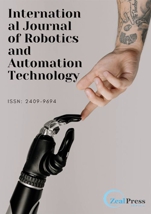
Co-Editor in Chief : Hongbo Guo & Dan Dobrota
Abbreviated key title: Int. J. Robot. Autom.
ISSN (online): 2409-9694
Access: Open Access
Periodicity: Continous
Publishing Since: 2014
Publisher: Zealpress
Contact: info@zealpress.com
Aim & Scope:
International Journal of Robotics and Automation Technology providing a platform to researchers, scientists, engineers, and practitioners throughout the world to publish the most up-to-date accomplishment, upcoming challenges, and thrilling applications in the field of Robotics and Automation Technology.
This technology deals with the design, construction, operation, and application of robots as well as control systems for operating equipment such as machinery, processes in factories, boilers, and heat treating ovens, switching in telephone networks, steering, and stabilization of ships or aircraft and other applications with minimal or reduced human intervention.
Areas of interest are:
- Medical Robotics
- Micro/Nano Robotics
- Robot Manipulation and Control
- Robot Sensors
- Mobile Robots and Multi-Robot Systems
- Bioinspired Robotics
- Automated Retail
- Automated Mining
- Automated Highway systems
- Automated Waste Management
- Home Automation
- Industrial Automation
- Humanoid Robotics
We published research works in the mode of original research articles, reviews, short communications and case reports.
Publication Process:
1) Initial Evaluation
Upon receiving the initial submission in Zeal Press journals, the authors receive an email acknowledging receipt of their article submission. The editorial staff first of all checks that all mandatory requirements, described in Author’s Guidelines, are fulfilled by the authors. After the submission goes through this phase successfully, it is sent to an editorial board member of the relevant journal. The journal editor reviews the article initially to see if it meets the minimum criteria for consideration, scholarliness, and topic suitability. If it does not, article is not approved for peer review and the author is notified by email with a brief explanation why the article cannot be considered for further publication process. If it does meet minimum criteria, the editor approves it for peer reviewing.
2) Peer Review
The handling editor selects at least two specialist reviewers, one of whom may be a member of the editorial board. The reviewers are chosen based on their knowledge in the relevant field and consent is sought first whether they would be interested/able in reviewing the article in a given time frame. Special attention is given to any possible conflict of interest at this stage and reviewers are provided with an opportunity to regret from reviewing an article where they discover any competing interest with the author/content of the article. Editors are supposed to keep them updated about the Editorial policies of the journal and work accordingly.
Reviewers are requested for their written report within the given time frame (generally, one month of receipt of the article). Reviewers are suggested to read guidelines for peer reviewers of the journal and adhere to these. Only the editor/peer review coordinator will ever know who the reviewers are.
3) Editorial Decision
Upon receiving the reports from reviewers, the handling editor or editorial board makes the final decision about acceptance/rejection for publication. If the manuscript needs improvements, these are detailed and the article is sent back to author for revision. This decision is based on the quality of the manuscript, reviewers’ recommendations, and the number of manuscripts already accepted in the journal. The authors are notified about editor’s decision for their manuscript via email.
A deadline for the revision can be suggested by the editor. Once the revised article is submitted, the editor decides whether to approve the article for final publication or to send it to one or both of the original reviewers for their follow-up evaluation and approval. If still more work is required by the reviewers before publication of the article, it is be returned to the author with referees’ comments for improvements and an editor’s letter. Maximally, 3 rounds of review are permissible for any submitted manuscript.
4) Copyediting, Production and Publication
Once an article has been approved for publication, and the author has resubmitted it with all corrections, it goes through a production process. An electronic versions of the typeset, edited version of the article, known as proofs or galleys is sent to the author for final inspection and approval. Authors have one week to review the final proof and may suggest any alterations. Once the article is returned, the managing editorial staff enters all the changes, and it is published online in the current volume of the journal within minimal possible time.
Handling editors/ Editorial Board Members/ EIC, as appropriate, are contacted if any post publication issue arises.